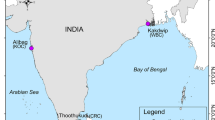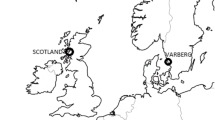Abstract
The red cusk-eel (Genypterus chilensis) is a native Chilean species with a high-value market, with the potential to diversify Chilean aquaculture. The objective of this study was to develop a set of microsatellite markers, estimate genetic parameters, determine population differentiation, and identify the population structure of wild and commercial populations of G. chilensis. We discovered 6427 microsatellites markers from RNA-seq data, of which 54.9%, 20.2% and 16.8% were di-, tri-, and tetranucleotides, respectively. We used 12 of these markers to genotype two sets of broodstock, one group from commercial fish, and one group from wild fish from the Coquimbo Region of G. chilensis. We estimate the genetic parameters of the markers, selecting ten polymorphic markers (PIC > 0.5). We observed differences in the inbreeding coefficient among populations, with high values of inbreeding in one broodstock set and lower values in the other groups. The evaluation of population differentiation using Fst showed small (0.0195) to large (0.1888) genetic differentiation between the groups. The structure analysis showed that commercial and wild groups were formed by three clusters, without relevant evidence of admixture process, suggesting that groups evaluated in this study are formed of at least three subpopulations of G. chilensis, which could be explained by the low or lack of migration suggested for this species. This is the first study that identifies a high number of molecular markers in G. chilensis, providing relevant information of the genetic structure of commercial and wild population of this species.




Similar content being viewed by others
References
Nielsen JG, Cohen DM, Markle DF, Robins CR (1999) An annotated and illustrated catalogue of pearlfishes, cusk-eels, brotulas and other ophidiiform fishes known to date. In: FAO species catalogue, No. 125, vol 18. FAO Fisheries Synopsis, FAO, Rome, p 178
Vega R, Pradenas M, Estrada JM, Ramirez D, Valdebenito I, Mardones A, Dantagnan P, Alfaro D, Encina F, Pichara C (2012) Evaluation and comparison of the efficiency of two incubation systems for Genypterus chilensis (Guichenot, 1848) eggs. Lat Am J Aquat Res 40(1):187–200. https://doi.org/10.3856/vol40-issue1-fulltext-18
Vega R, Estrada JM, Ramirez D, Flores C, Zamorano J, Encina F, Mardones A, Valdebenito I, Dantagnan P (2015) Growth of cusk eel Genypterus chilensis juveniles in culture conditions. Lat Am J Aquat Res 43(2):344–350. https://doi.org/10.3856/vol43-issue2-fulltext-11
Smith PJ (1979) Glucosephosphate isomerase and phosphoglucomutase polymorphisms in the New-Zealand ling Genypterus blacodes. Comp Biochem Phys B 62(4):573–577. https://doi.org/10.1016/0305-0491(79)90136-6
Ward RD, Reilly A (2001) Development of microsatellite loci for population studies of the pink ling, Genypterus blacodes (Teleostei: Ophidiidae). Mol Ecol Notes 1(3):173–175. https://doi.org/10.1046/j.1471-8278.2001.00066.x
Ward RD, Appleyard SA, Daley RK, Reilly A (2001) Population structure of pink ling (Genypterus blacodes) from south-eastern Australian water, inferred from allozyme and microsatellite analyses. Mar Freshw Res 52(7):965–973. https://doi.org/10.1071/Mf01014
Canales-Aguirre CB, Ferrada S, Hernandez CE, Galleguillos R (2010) Usefulness of heterologous microsatellites obtained from Genypterus blacodes (Schneider 1801) in species Genypterus off the southeast Pacific. Gayana 74(1):74–77
Weber JL, May PE (1989) Abundant class of human DNA polymorphisms which can be typed using the polymerase chain-reaction. Am J Hum Genet 44(3):388–396
Gui JF, Zhu ZY (2012) Molecular basis and genetic improvement of economically important traits in aquaculture animals. Chinese Sci Bull 57(15):1751–1760. https://doi.org/10.1007/s11434-012-5213-0
Wilke K, Jung M, Chen YZ, Geldermann H (1994) Porcine (Ct)(N) sequences—structure and association with dispersed and tandem repeats. Genomics 21(1):63–70. https://doi.org/10.1006/geno.1994.1225
Patel A, Dettleff P, Hernandez E, Martinez V (2016) A comprehensive transcriptome of early development in yellowtail kingfish (Seriola lalandi). Mol Ecol Res 16(1):364–376. https://doi.org/10.1111/1755-0998.12451
Du M, Li N, Niu BZ, Liu YH, You DJ, Jiang DF, Ruan CQ, Qin ZQ, Song TW, Wang WT (2018) De novo transcriptome analysis of Bagarius yarrelli (Siluriformes: Sisoridae) and the search for potential SSR markers using RNA-Seq. PLoS ONE 13(2):e0190343. https://doi.org/10.1371/journal.pone.0190343
Ariede RB, Freitas MV, Hata ME, Matrochirico VA, Utsunomia R, Mendonca FF, Foresti F, Porto-Foresti F, Hashimoto DT (2018) Development of microsatellite markers using next-generation sequencing for the fish Colossoma macropomum. Mol Biol Rep 45(1):9–18. https://doi.org/10.1007/s11033-017-4134-z
Aedo JE, Maldonado J, Estrada JM, Fuentes EN, Silva H, Gallardo-Escarate C, Molina A, Valdes JA (2014) Sequencing and de novo assembly of the red cusk-eel (Genypterus chilensis) transcriptome. Mar Genom 18:105–107. https://doi.org/10.1016/j.margen.2014.08.001
da Maia LC, Palmieri DA, de Souza VQ, Kopp MM, de Carvalho FI, Costa de Oliveira A (2008) SSR locator: tool for simple sequence repeat discovery integrated with primer design and PCR simulation. Int J Plant Genom 2008:412696. https://doi.org/10.1155/2008/412696
Aedo JE, Maldonado J, Aballai V, Estrada JM, Bastias-Molina M, Meneses C, Gallardo-Escarate C, Silva H, Molina A, Valdes JA (2015) mRNA-seq reveals skeletal muscle atrophy in response to handling stress in a marine teleost, the red cusk-eel (Genypterus chilensis). BMC Genom 16:1024. https://doi.org/10.1186/s12864-015-2232-7
Van Oosterhout C, Hutchinson WF, Wills DPM, Shipley P (2004) MICRO-CHECKER: software for identifying and correcting genotyping errors in microsatellite data. Mol Ecol Notes 4(3):535–538. https://doi.org/10.1111/j.1471-8286.2004.00684.x
Peakall R, Smouse PE (2006) GENALEX 6: genetic analysis in Excel. Population genetic software for teaching and research. Mol Ecol Notes 6(1):288–295. https://doi.org/10.1111/j.1471-8286.2005.01155.x
Peakall R, Smouse PE (2012) GenAlEx 6.5: genetic analysis in Excel. Population genetic software for teaching and research—an update. Bioinformatics 28(19):2537–2539. https://doi.org/10.1093/bioinformatics/bts460
Botstein D, White RL, Skolnick M, Davis RW (1980) Construction of a genetic-linkage map in man using restriction fragment length polymorphisms. Am J Hum Genet 32(3):314–331
Rousset F (2008) GENEPOP’007: a complete re-implementation of the genepop software for Windows and Linux. Mol Ecol Res 8(1):103–106. https://doi.org/10.1111/j.1471-8286.2007.01931.x
Pritchard JK, Stephens M, Donnelly P (2000) Inference of population structure using multilocus genotype data. Genetics 155(2):945–959
Evanno G, Regnaut S, Goudet J (2005) Detecting the number of clusters of individuals using the software STRUCTURE: a simulation study. Mol Ecol 14(8):2611–2620. https://doi.org/10.1111/j.1365-294X.2005.02553.x
Beaumont MA (2005) Adaptation and speciation: what can F(st) tell us? Trends Ecol Evol 20(8):435–440. https://doi.org/10.1016/j.tree.2005.05.017
Ward RD (2000) Genetics in fisheries management. Hydrobiologia 420:191–201. https://doi.org/10.1023/A:1003928327503
Hauser L, Seeb JE (2008) Advances in molecular technology and their impact on fisheries genetics. Fish Fish 9(4):473–486. https://doi.org/10.1111/j.1467-2979.2008.00306.x
Xu K, Duan W, Xiao J, Tao M, Zhang C, Liu Y, Liu S (2015) Development and application of biological technologies in fish genetic breeding. Sci China Life Sci 58(2):187–201. https://doi.org/10.1007/s11427-015-4798-3
Hulata G (2001) Genetic manipulations in aquaculture: a review of stock improvement by classical and modern technologies. Genetica 111(1–3):155–173
Canales-Aguirre CB, Ferrada S, Hernandez CE, Galleguillos R (2010) Population structure and demographic history of Genypterus blacodes using microsatellite loci. Fish Res 106(1):102–106. https://doi.org/10.1016/j.fishres.2010.06.010
Fang DA, Zhou YF, Duan JR, Zhang MY, Xu DP, Liu K, Xu P, Wei Q (2015) Screening potential SSR markers of the anadromous fish Coilia nasus by de novo transcriptome analysis using Illumina sequencing. Genet Mol Res 14(4):14181–14188. https://doi.org/10.4238/2015.November.13.1
Luo W, Deng W, Yi SK, Wang WM, Gao ZX (2013) Characterization of 20 polymorphic microsatellites for Blunt snout bream (Megalobrama amblycephala) from EST sequences. Conserv Genet Resour 5(2):499–501. https://doi.org/10.1007/s12686-012-9837-9
Basiita RK, Zenger KR, Mwanja MT, Jerry DR (2018) Gene flow and genetic structure in Nile perch, Lates niloticus, from African freshwater rivers and lakes. PLoS ONE 13(7):e0200001. https://doi.org/10.1371/journal.pone.0200001
DeWoody JA, Avise JC (2000) Microsatellite variation in marine, freshwater and anadromous fishes compared with other animals. J Fish Biol 56(3):461–473. https://doi.org/10.1111/j.1095-8649.2000.tb00748.x
An HS, Kim EM, Kang HW, Han HS, Lee JW, Park JY, Myeong JI, An CM (2013) Comparative genetic diversity of wild and hatchery-produced populations of tongue sole (Cynoglossus semilaevis) using multiplex PCR assays with polymorphic microsatellite markers. Genet Mol Res 12(4):6331–6343. https://doi.org/10.4238/2013.December.4.20
Amos W, Wilmer JW, Fullard K, Burg TM, Croxall JP, Bloch D, Coulson T (2001) The influence of parental relatedness on reproductive success. Proc R Soc B 268(1480):2021–2027. https://doi.org/10.1098/rspb.2001.1751
An HS, Kim EM, Lee JH, Noh JK, An CM, Yoon SJ, Park KD, Myeong JI (2011) Population genetic structure of wild and hatchery black rockfish Sebastes inermis in Korea, assessed using cross-species microsatellite markers. Genet Mol Res 10(4):2492–2504. https://doi.org/10.4238/2011.October.13.6
Smith PJ, Francis RICC (1982) A glucosephosphate isomerase polymorphism in New-Zealand ling Genypterus blacodes. Comp Biochem Phys B 73(3):451–455. https://doi.org/10.1016/0305-0491(82)90057-8
Acknowledgements
This study was supported by CONICYT/FONDAP [Grant Number 15110027] awarded to Juan Antonio Valdés and Alfredo Molina, and CONICYT FONDECYT Postdoctorado [Grant Number 3180283] awarded to Phillip Dettleff.
Author information
Authors and Affiliations
Corresponding author
Ethics declarations
Conflict of interest
The authors declare that there are no financial or non-financial conflict of interest.
Ethical approval
The procedures with animals in this study were according to animal welfare procedures of the National Commission for Scientific and Technological Research (CONICYT) of the Chilean government and approved by the bioethical committees of the Universidad Andres Bello (Approbation Number 0072018).
Additional information
Publisher's Note
Springer Nature remains neutral with regard to jurisdictional claims in published maps and institutional affiliations.
Electronic supplementary material
Below is the link to the electronic supplementary material.
Rights and permissions
About this article
Cite this article
González, P., Dettleff, P., Valenzuela, C. et al. Evaluating the genetic structure of wild and commercial red cusk-eel (Genypterus chilensis) populations through the development of novel microsatellite markers from a reference transcriptome. Mol Biol Rep 46, 5875–5882 (2019). https://doi.org/10.1007/s11033-019-05021-0
Received:
Accepted:
Published:
Issue Date:
DOI: https://doi.org/10.1007/s11033-019-05021-0




